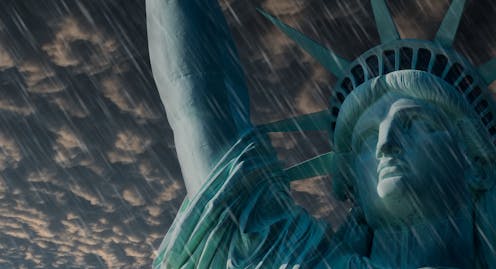Tourism to the US is tanking. Flight Centre is facing a $100m hit as a result
- Written by The Conversation

Flight Centre, one of the world’s largest travel agencies, has warned it could lose more than A$100 million in earnings this year, citing weakening demand for travel to the United States.
In a statement to the Australian Securities Exchange (ASX) this week, the company pointed to “volatile trading conditions” linked to changes in US entry policies.
This is the first major indication from an Australian company that travel to the US is becoming a serious concern. It follows growing consumer fears linked to US immigration checks, reports of tourists being detained, and rising costs.
Australian visitor numbers to the US fell by 7% in March compared with the same time last year – the sharpest fall since the COVID pandemic.
Australians are not the only ones staying away. New US data for March show sharp drops in visitors from key markets: Germany (down 28%), Spain (25%), the United Kingdom (18%) and South Korea (15%), to name a few. In total, inbound tourism fell 11.6%.
Even Canadian travellers, traditionally the US’s most reliable market, dropped by more than 900,000 or 17% in March, as growing numbers of Canadians opt to boycott US holidays.
What was once a reliable flow of high-spending international travellers is becoming a much quieter stream.
America’s welcome mat is wearing thin
The US, long marketed as the land of opportunity and adventure, is increasingly perceived as unwelcoming. Tighter border scrutiny, aggressive immigration enforcement, and a sharp shift in political tone have made travellers wary.
While the Flight Centre statement used careful language, its chief executive Graham Turner was clear, saying:
People from Europe, the United Kingdom and Australia really don’t want to go to the States, given what’s happening there. We’re hearing more and more people don’t want to go through passport control.
Reports of tourists being detained, shackled and deported at US airports over minor alleged visa issues or misunderstandings have circulated widely. In some cases, visitors have had their phones and electronic devices searched without clear cause. For many travellers, that is a risk not worth taking.
Governments have started to respond. Several countries, including New Zealand, Germany, France, Denmark and Finland, have updated their official travel advice for the US, urging citizens to exercise caution when visiting. The message filtering through international media is clear: the US is not as easy, safe or welcoming as it once seemed.
But while diplomatic warnings grow louder, the economic costs of America’s hardening stance are only beginning to register.
Tourism: America’s forgotten export
While President Donald Trump has slapped tariffs on goods imports from most countries, he has ignored the contribution of services trade to the economy. The US actually runs a surplus in services such as education and tourism. Trump has dismissed the decline in visitors as “not a big deal”.
The trade wars have focused on goods – cars, steel, farm products – but the service sector, which makes up a larger share of the economy, bears the hidden costs.
Tourism is the US’ biggest service export, contributing more than US$2.3 trillion to the economy and one in ten jobs. That’s a bigger contribution than manufacturing jobs, which account for about 8% of total US employment.
As a driver of economic prosperity, tourism isn’t simply about leisure; it sustains local businesses, rural economies and millions of livelihoods.
A double blow to the tourism experience
While the decline in arrivals has been widely reported, the experience for those who still choose to visit is also likely to change.
Tourism relies on global supply chains, from food to hotel amenities to rental car fleets. Trade war tariffs have raised input costs across the board. Hotels, restaurants, airlines and attractions are passing those higher costs onto customers.
Labour shortages are intensifying the problem. Nearly 20% of the US hospitality workforce was born overseas. Cuts to seasonal work visas and heightened deportation fears have left many businesses struggling to find staff, compounding existing labour shortages.
The burden is heaviest on small- and medium-sized enterprises, which form the bedrock of the US economy and play a central role in accommodation, dining and local tourism experiences.
A quiet but costly erosion
Tourism is not just a big part of the economy; it’s also a soft power, shaping how the world perceives a nation through its culture, values and hospitality.
Every visitor who feels unwelcome, scrutinised or disappointed is not just a lost sale, but a lost connection.
Research group Tourism Economics forecasts the US could lose up to US$10 billion in international travel spending in 2025 if current trends continue.
And while manufacturing job announcements grab headlines, the slow erosion of America’s tourism brand may leave a longer, deeper scar on its culture, its communities and its place in the world.
The Flight Centre downgrade is not an isolated warning. It is a symptom of a broader shift, one that risks turning visitors away for good.
And for thousands of US businesses, workers and communities – and now Australian ones too – the losses may not be so easily shrugged off.














